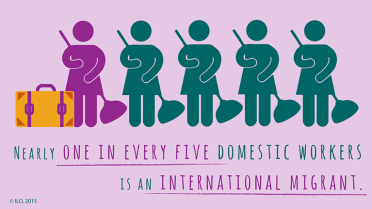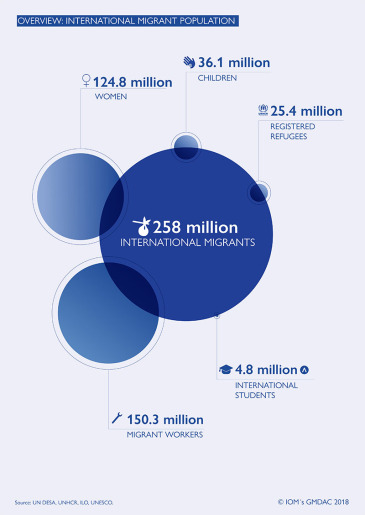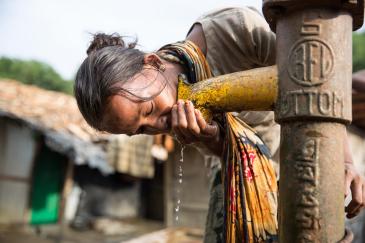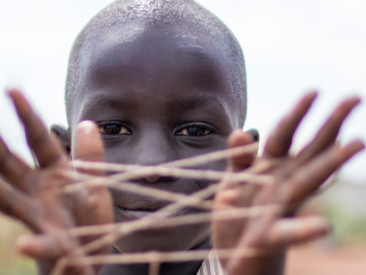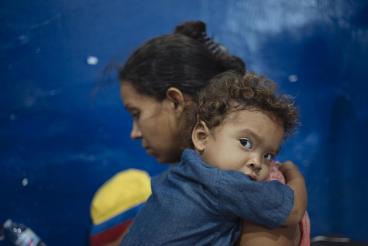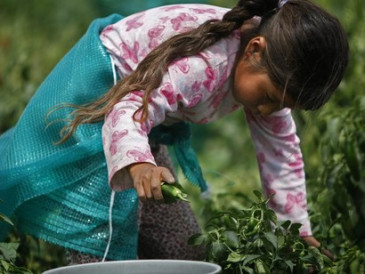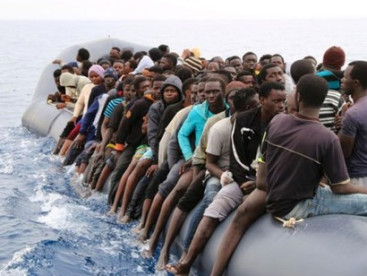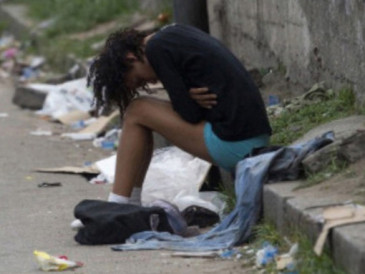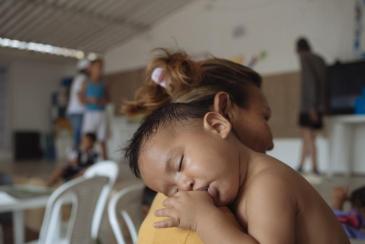The Most Expensive 529 Billion Dollars
TRANSCEND MEMBERS, 13 May 2019
Baher Kamal | Human Wrongs Watch – TRANSCEND Media Service
The immense human cost over 260 million migrant workers do pay to rescue their families.
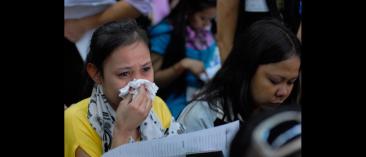
Filipinos fill out the necessary forms after arriving in Manila from Damascus, Syria. © IOM. (Photo: Ray Leyesa)
8 May 2019 – The World Bank (WB) on 8 April 2019 reported that migrants remittances to low- and middle-income countries reached a record high in 2018.
According to the WB study, officially recorded annual remittance flows to those countries reached 529 billion dollars last year, an increase of 9.6 percent over the previous record high of 483 billion dollars in 2017.
Significantly, these migrants most hardly-won savings do also benefit rich countries. In fact, the WB reports that global remittances, “which include flows to high-income countries,” reached 689 billion dollars in 2018, up from 633 billion dollars in 2017.
“Remittances on track to become the largest source of external financing in developing countries,” wrote on this Dilip Ratha, lead economist at the World Bank.
In a breakdown of this data, the WB informs that, regionally, growth in remittance inflows ranged from almost 7 percent in East Asia and the Pacific to 12 percent in South Asia.
The oil factor
And that the overall increase was driven by a stronger economy and employment situation in the United States and a rebound in outward flows from some Gulf Cooperation Council countries (United Arab Emirates, Bahrain, Saudi Arabia, Oman, Qatar, and Kuwait), as well as the Russian Federation.
Excluding China, remittances to low- and middle-income countries (462 billion dollars) were “significantly larger than foreign direct investment flows in 2018 (344 billion dollars).”
Foreign Direct Investment flows record the value of cross-border transactions related to direct investment during a given period of time, according to the Organisation for Economic Co-operation and Development.
The top remittance recipients were India with 79 billion dollars, followed by China (67 billions), Mexico (36 billions), the Philippines (34 billions), and Egypt (29 billions).
The world financial institution also estimates that, in 2019, remittance flows to low- and middle-income countries are expected to reach 550 billion dollars, to become their largest source of external financing.
Lost in commissions
The 529 billion dollars that migrant-workers have transferred to their countries of origin in 2018 came obviously at a high costs–both economic and human.
On the one hand, the global average cost of sending 200 dollars remained high at around 7 percent in the first quarter of 2019, according to the WB’s Remittance Prices Worldwide database.
This means that each migrant is forced to sacrifice, in the concept of money transfer commissions, 7 of 100 dollars that she or he managed to save at the cost of renouncing to many basic human needs.
Meantime, remittance costs across many African corridors and small islands in the Pacific remain above 10 percent.This means that African migrants are compelled to pay as much as 1 in 10 dollars of their savings in the concept of money transfer fees to private banking and financial business.
On this, the WB says that banks were the most expensive remittance channels, charging an average fee of 11 percent in the first quarter of 2019, while post offices were the next most expensive, at over 7 percent.
On ways to lower remittance costs, Dilip Ratha, lead author of the study,says that “remittances are on track to become the largest source of external financing in developing countries. The high costs of money transfers reduce the benefits of migration.”
The immense human cost
For his part, Michal Rutkowski, senior director of the Social Protection and Jobs Global Practice at the World Bank, says that “millions of low-skilled migrant workers are vulnerable to recruitment malpractices, including exorbitant recruitment costs.”
IOM, the UN Migration Agency released a new report on migrant deaths and disappearances worldwide through its Berlin-based Global Migration Data Analysis Centre.
Since 2014, more than 23,000 migrant deaths and disappearances have been recorded globally by the IOM. The real number is likely to be much higher as many deaths are never recorded.
How many migrant workers are there?
A new study launched on 5 December 2018 by the International Labour Organization (ILO) reveals that the number of migrant workers has jumped by millions, leaving some countries without “the most productive part of their workforce.”
According to the second edition of ILO’s Global Estimates on International Migrant Workers, approximately 164 million people left home in search of work between 2013 and 2017– a nine percent increase since 2013, when that number stood at 150 millions.
Breaking down the figures, 96 milliona are men, a rise of two percent, while 68 milliona are women, a fall of 2 percent compared to 2013.
Of the 164 million migrant workers worldwide, approximately:
-
- 111.2 millions, or 67.9 percent, live in high-income countries.
- 30.5 millions, or 18.6 percent, in upper middle-income countries.
- 16.6 millions, or 10.1 percent, in lower middle-income countries,
- 5.6 millions, or 3.4 percent, in low-income countries.
And where do they live?
A sample group of nearly two-thirds of migrant workers shows that 23 percent are in North America; 23.9 percent in Northern, Southern and Western Europe; and 13.9 percent in Arab countries.
Other regions that host more than five percent of migrant workers include Eastern Europe, Sub-Saharan Africa, South-Eastern Asia and the Pacific, and Central and Western Asia. In contrast, North Africa hosts less than one per cent.
Why do migrants migrate?
Having said that, a harsh question arises: why all these millions and millions of human beings have been forced to abandon their homes and families to fall prey to smugglers, deadly voyages, separation of their children, detention, torture, forced repatriation, etcetera?
Let alone being victims of human traffickers who buy and sell them as just human flesh merchandise to feed the business of prostitution, child recruitment as soldiers, slave-labourers and even for trading their organs?
Three chief reasons lay behind most of the migrants need to flee:
- Impoverishment: Most migrants and refugees proceed from former European colonies in Africa, Asia and Latin America and the Caribbean, from countries which had been practically enslaved under European military occupation and which, since their formal independence, have been easy prey to intensive exploitation by big private business. One of the dramatic consequences of that occupation and the ongoing exploitation is the deepening impoverishment of native populations, a fact that has been aggravated by the dominant neo-liberalism-led ‘globalisation.’
- Conflicts: most of the around 40 ongoing armed conflicts are due to either the fictitious splitting of nations and compact ethnic communities through aribitrarian borders imposed by former European colonisers, or more recently directly or indirectly fuelled by the voracious exploitation of natural resources by huge translational private business,
- Climate change: the growing wave of unusual droughts,floods, loss of harvests, of homes and lives, which is caused by climate change, which an immense number of the migrants’ countries of origin did no generate.
Just know that a whole continent like Africa, which is home to around 1,2 billion human beings, has contributed just 4 per cent to greenhouse gas emissions, while bearing the brunt of more than 80 percent of its dramatic consequences.
These three main reasons laying behind the forced migration of so many millions of human beings, should suffice to explain why the number of people fleeing exploitation, wars and climate change-driven disasters, need to search for other places where to feel safer or simply just survive, while working hard to help their families also survive.
One billion climate migrants, refugees?
Imagine a world with as many as one billion people facing harsh climate change impacts resulting in devastating droughts and/or floods, extreme weather, destruction of natural resources, in particular lands, soils and water, and the consequence of severe livelihoods conditions, famine and starvation.
Although not yet based on definite scientific projections, the proven speed with which the process of climate change has been taking place, might lead to such a scenario by 2050. If so, 1 in 9 human beings would be on the move by then.
Currently, forecasts vary from 25 million to 1 billion environmental migrants by 2050, moving either within their countries or across borders, on a permanent or temporary basis, with 200 million being the most widely cited estimate, according to a 2015 study carried out by the Institute for Environment and Human Security of the United Nations University.
Other specialised sources estimate that “every second, one person is displaced by disaster.” On this, the Oslo-based Norwegian Refugee Council (NRC) reports that in 2015 only, more than 19.2 million people fled disasters in 113 countries. “Disasters displace three to ten times more people than conflict and war worldwide.”
Exploitation, Slavery…
Among the numerous human costs of those remittances, there is the fact that millions more migrant workers mean their countries of origin lose ‘most productive part’ of workforce.
The International Labour Organization (ILO) underscored that domestic workers are one of the groups “most vulnerable to exploitation, violence, harassment and forced labour, saying that “many women end up being trapped in abusive worksituations which in some cases may amount to modern forms of slavery.”
Sixty-seven million domestic workers who care for our homes and loved ones frequently suffer “violence, harassment, exploitation and coercion – ranging from verbal abuse to sexual violence, and sometimes even death.” Those who live -in-home are especially vulnerable.
“At the root of this situation is discrimination,” explains Philippe Marcadent, Chief of the ILO Branch related to Inclusive Labour Markets, Labour Relations and Working Conditions.
“Domestic workers are often not recognised as workers, and face discrimination as women, often from poor and marginalised groups, such as migrants and indigenous peoples.”
For many, daily abuses like lack of rest and non-payment of wages can quickly turn into forced labour.
Forced labour can be imposed to adults and children, by State authorities, by private enterprises or by individuals. It is observed in all types of economic activity, such as domestic work, construction, agriculture, manufacturing, sexual exploitation, forced begging, etc. and in every country.
“Traditional practices of forced labour, such as vestiges of slavery or slave-like practices, and various forms of debt bondage, as well as new forms of forced labour that have emerged in recent decades, such as human trafficking.”
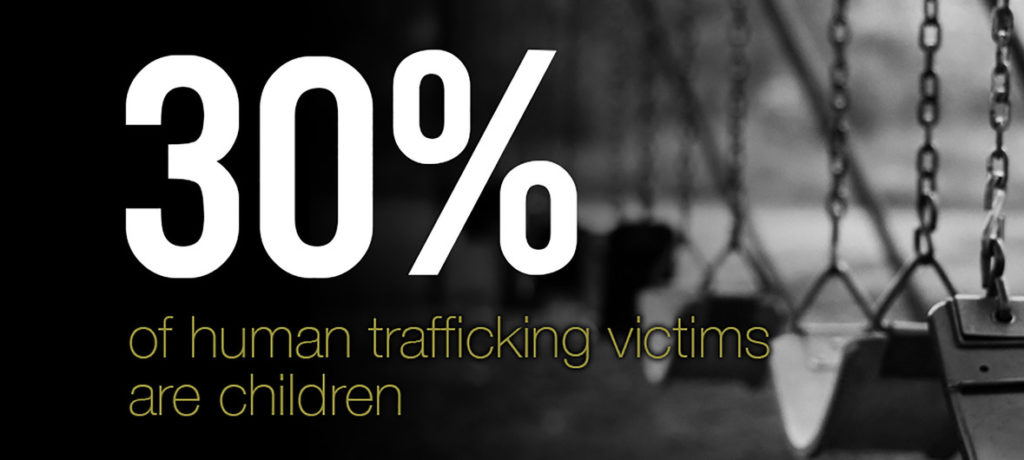
UNODC | #EndHumanTrafficking visual. According to the UNODC Global Report on Trafficking in Persons, 30% of human trafficking victims are children.
Facts and figures:
- An estimated 40.3 million people are in modern slavery, including 24.9 in forced labour and 15.4 millions in forced marriage.
- There are 5.4 victims of modern slavery for every 1,000 people in the world.
- 1 in 4 victims of modern slavery are children.
- Out of the 24.9 million people trapped in forced labour, 16 million people are exploited in the private sector such as domestic work, construction or agriculture; 4.8 million people in forced sexual exploitation, and 4 million people in forced labour imposed by state authorities.
- Women and girls are disproportionately affected by forced labour, accounting for 99 percent of victims in the commercial sex industry, and 58 percent in other sectors.
For its part, the Global Report On Trafficking In Persons, released on 29 January 2019 by the United Nations Office on Drugs and Crime (UNODC) at UN headquarters in New York, shows a record-high number of cases detected during 2016, but also the largest recorded conviction rate of traffickers.
Anyway, women and girls remain a major target, according to UNODC. “Traffickers the world over continue to target women and girls,” wrote Executive Director Yury Fedotov, in the report’s preface. “The vast majority of detected victims of trafficking for sexual exploitation and 35 per cent of those trafficked for forced labour are female.”
The report notes “considerable regional differences in the sex and age profiles of detected trafficking victims.”
In West Africa, most of the detected victims are children, both boys and girls, while in South Asia, victims are equally reported to be men, women and children. In Central Asia, a larger share of adult men is detected compared to other regions, while in Central America and the Caribbean, more girls are recorded.

© UNICEF/UNI91025/Noorani Two girls apply make-up at Kandapara, a brothel in the city of Tangail, Bangladesh. A man offered them to find them jobs, but instead sold them to Kandapara.
Sexual exploitation, top form of trafficking
Most of the victims detected globally are trafficked for sexual exploitation, especially in the Americas, Europe, and East Asia and the Pacific. In sub-Saharan Africa and the Middle East, trafficking for forced labour is the most commonly detected form. In Central Asia and South Asia, trafficking for forced labour and sexual exploitation are equally prevalent,
Other forms of human trafficking include: girls forced into marriage, more commonly detected in South-East Asia; children for illegal adoption, more common in Central and South American countries; forced criminality, mainly reported in Western and Southern Europe; and organ removal, primarily detected in North Africa, and Central and Eastern Europe.
“Victims can be in restaurants, fisheries, brothels, farms, homes, and even organ trafficking and illegal adoption,” said Rani Hong, who survived child trafficking herself as she was taken from her family in India at age 7, submitted to intimidation, physical abuse and slavery, until she was sold for illegal adoption in Canada and later the United States.
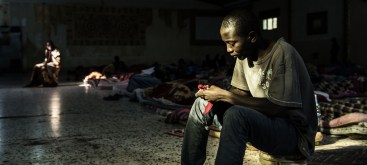
UNICEF/UN052822/Romenzi A migrant sits in a patch of light entering through one of only two windows as he tries to warm himself up at a detention centre, located in Libya, 1 February 2017. At the time of UNICEF’s visit, 160 men were being detained there.
Begging, porno, forced marriage…
Many other forms, such as trafficking for exploitation in begging, or for the production of pornographic material, are reported in different parts of the world.
The report also shows that armed conflicts can increase vulnerability to trafficking in different ways as areas with weak rule of law and lack of resources to respond to crime, provide traffickers with a fertile terrain to carry out their operations, preying on those who are desperately in need.
Armed groups and other criminals may take the opportunity to traffic victims – including children – for sexual exploitation, sexual slavery, forced marriage, armed combat and various forms of forced labour. This is the case for example in sub-Saharan Africa, North Africa and the Middle East, South-East Asia and elsewhere.
In some refugee camps in the Middle East, also, it has been documented that girls and young women have been ‘married off’ without their consent and subjected to sexual exploitation in neighbouring countries.
In addition, recruitment of children for use as armed combatants is widely documented.
UNODC’s report notes that within conflict zones, armed groups can use trafficking as a strategy to assert territorial dominance, spread fear among civilians in the territories where they operate to keep the local population under control.
Sex slaves
They may also use women and girls as ‘sex slaves’ or force them into marriages to appeal to new potential male recruits.
The study shows that in all the conflicts examined for the report, forcibly displaced populations (refugees and internally displaced families) have been specifically targeted: from settlements of Syrian and Iraqi refugees, to Afghans and Rohingya fleeing conflict and persecution.
Notably, the risk faced by migrants and refugees travelling through conflict areas, such as Libya or parts of sub-Saharan Africa, is also well documented: in Libya, for example, militias control some detention centres for migrants and refugees and are coercing detained migrants and asylum seekers for different exploitative purposes.
“While we are far from ending impunity, we have made headway in the 15 years since the Protocol against Trafficking in Persons entered into force,” said UNODC’s chief, as he noted that “nearly every country now has legislation in place criminalising human trafficking”.
Abused, maimed, killed…
Children are being smuggled, sexually abused, maimed, killed for their vital organs, recruited as soldiers or otherwise enslaved.
Not only: 69 million children under five will die from mostly preventable causes, 167 million will live in poverty, and 263 million are out of school. And 750 million women will have been married as children by 2030.
According to the International Labour Organization, forced labour alone (one component of human trafficking) generates an estimated 150 billion dollars in profits per annum as of 2014.
All the above is just one part of the 529 billion dollars that migrant workers had to save in one year to rescue their families from imposed impoverishment, war and climate catastrophes that they did anything but cause.
____________________________________________________
Read also:
- Libya: Up to One Million Enslaved Migrants, Victims of ‘Europe’s Complicity’
- To Be a Latin-American Migrant in Madrid
- To Be an Egyptian Migrant in Rome (and by the Way Make Great Pizza)
- To Be a Nigerian Migrant in Italy
- Climate Migrants Might Reach One Billion by 2050
- Yemen: African Migrants Beaten, Starved, Sexually Violated by Criminal Groups
- African Migrants Bought and Sold Openly in ‘Slave Markets’ in Libya
- Mideast: Drought to Turn People into Eternal Migrants, Prey to Extremism?
 Baher Kamal, a member of the TRANSCEND Network for Peace Development Environment, is an Egyptian-born, Spanish national, secular journalist, with over 45 years of professional experience — from reporter to special envoy to chief editor of national dailies and an international news agency. Baher is former Senior Advisor to the Director General of the international news agency IPS (Inter Press Service) and he also contributed to prestigious magazines such as TRANSCEND Media Service, GEO, Muy Interesante, and Natura, Spain. He is also publisher and editor of Human Wrongs Watch.
Baher Kamal, a member of the TRANSCEND Network for Peace Development Environment, is an Egyptian-born, Spanish national, secular journalist, with over 45 years of professional experience — from reporter to special envoy to chief editor of national dailies and an international news agency. Baher is former Senior Advisor to the Director General of the international news agency IPS (Inter Press Service) and he also contributed to prestigious magazines such as TRANSCEND Media Service, GEO, Muy Interesante, and Natura, Spain. He is also publisher and editor of Human Wrongs Watch.
Go to Original – human-wrongs-watch.net
Tags: Africa, Children, Conflict, Economics, Environment, Europe, Geopolitics, Human Rights, Justice, Migrants, Politics, Power, Refugees, Slave labor, Slavery, UK, UN, USA, Violence, West, World
DISCLAIMER: The statements, views and opinions expressed in pieces republished here are solely those of the authors and do not necessarily represent those of TMS. In accordance with title 17 U.S.C. section 107, this material is distributed without profit to those who have expressed a prior interest in receiving the included information for research and educational purposes. TMS has no affiliation whatsoever with the originator of this article nor is TMS endorsed or sponsored by the originator. “GO TO ORIGINAL” links are provided as a convenience to our readers and allow for verification of authenticity. However, as originating pages are often updated by their originating host sites, the versions posted may not match the versions our readers view when clicking the “GO TO ORIGINAL” links. This site contains copyrighted material the use of which has not always been specifically authorized by the copyright owner. We are making such material available in our efforts to advance understanding of environmental, political, human rights, economic, democracy, scientific, and social justice issues, etc. We believe this constitutes a ‘fair use’ of any such copyrighted material as provided for in section 107 of the US Copyright Law. In accordance with Title 17 U.S.C. Section 107, the material on this site is distributed without profit to those who have expressed a prior interest in receiving the included information for research and educational purposes. For more information go to: http://www.law.cornell.edu/uscode/17/107.shtml. If you wish to use copyrighted material from this site for purposes of your own that go beyond ‘fair use’, you must obtain permission from the copyright owner.

